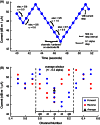A fast method for measuring psychophysical thresholds across the cochlear implant array
- PMID: 25656797
- PMCID: PMC4324086
- DOI: 10.1177/2331216515569792
A fast method for measuring psychophysical thresholds across the cochlear implant array
Abstract
A rapid threshold measurement procedure, based on Bekesy tracking, is proposed and evaluated for use with cochlear implants (CIs). Fifteen postlingually deafened adult CI users participated. Absolute thresholds for 200-ms trains of biphasic pulses were measured using the new tracking procedure and were compared with thresholds obtained with a traditional forced-choice adaptive procedure under both monopolar and quadrupolar stimulation. Virtual spectral sweeps across the electrode array were implemented in the tracking procedure via current steering, which divides the current between two adjacent electrodes and varies the proportion of current directed to each electrode. Overall, no systematic differences were found between threshold estimates with the new channel sweep procedure and estimates using the adaptive forced-choice procedure. Test-retest reliability for the thresholds from the sweep procedure was somewhat poorer than for thresholds from the forced-choice procedure. However, the new method was about 4 times faster for the same number of repetitions. Overall the reliability and speed of the new tracking procedure provides it with the potential to estimate thresholds in a clinical setting. Rapid methods for estimating thresholds could be of particular clinical importance in combination with focused stimulation techniques that result in larger threshold variations between electrodes.
Keywords: cochlear implant; psychophysics; threshold.
© The Author(s) 2015.
Figures









References
-
- Berenstein C. K., Mens L. H., Mulder J. J., Vanpoucke F. J. (2008) Current steering and current focusing in cochlear implants: comparison of monopolar, tripolar and virtual channel electrode configurations. Ear and Hearing 29: 250–260. - PubMed
-
- Bierer J. A. (2007) Threshold and channel interaction in cochlear implant users: Evaluation of the tripolar electrode configuration. Journal of the Acoustical Society of America 121: 1642–1653. - PubMed
-
- Bierer J. A., Middlebrooks J. C. (2002) Auditory cortical images of cochlear-implant stimuli: Dependence on electrode configuration. Journal of Neurophysiology 87: 478–492. - PubMed
Publication types
MeSH terms
Grants and funding
LinkOut - more resources
Full Text Sources
Other Literature Sources
Medical

